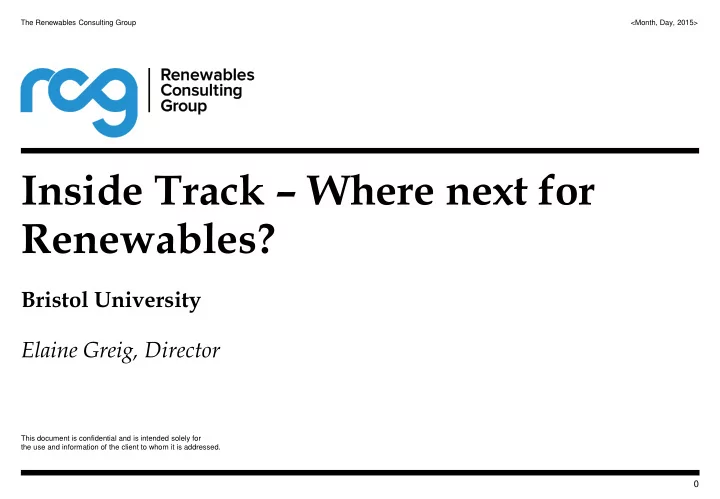

The Renewables Consulting Group <Month, Day, 2015> Inside Track – Where next for Renewables? Bristol University Elaine Greig, Director This document is confidential and is intended solely for the use and information of the client to whom it is addressed. 0
My career: Elaine Greig Current role - Director, Head of EMEA Renewables Consulting Group Previous roles » Head of Offshore Renewables, DNV-GL Renewables » Project Director, Vattenfall » Development Manager, Amec Wind » Grid Connections Manager & Electrical Engineer, Amec Wind » Power Systems Analyst, ERA Technology » Applications Engineer, PB Power Education Projects » BSc MEng Electrical » PD: Aberdeen Bay Offshore Wind Farm, £10m development of £250m capex Engineering, Manchester » PD: Edinbane Onshore wind farm, Skye, £60m capex » MBA, Durham » Grid connections manager & electrical engineer: 30 onshore projects; » MIET offshore - Lynn, Docking Shoal, Race Bank, Thanet, Aberdeen, Beatrice demonstrator, Cape Wind (USA) » CEng, Engineering Council » Fault level, load flow, transient stability, harmonic & protection studies » Member RedR 1 The Renewables Consulting Group
EU Electricity – installed capacity (MW) EU Electricity 2000, % EU Electricity 2015, % Biomass 1% Other 2% Wind 2% Other 2% Fuel Oil 4% Fuel Oil Gas Solar PV 11% Coal A step 21% 11% 24% change for renewables Gas Nuclear 17% 13% Coal 17% Nuclear 23% Hydro 15% Hydro Wind 21% 16% 908 GW 545 GW Alongside a large increase in usage Source: EWEA Annual Statistics 2015 doesn’t show what actually used, capacity factors will be different by technology 2 The Renewables Consulting Group
The UK’s changing electricity generation mix – how we got to here UK Electricity source % Coal dominates from industry inception 90 (late 1800s) 80 2016 – 70 battery boom - potential enabler to 60 the continued rise of 50 renewables Fossil fuels used depending on 1990s ‘dash 40 cost & availability for gas’ Nuclear build 30 programme 20 The ‘rise of 10 renewables’ 0 1960 1961 1962 1963 1964 1965 1966 1967 1968 1969 1970 1971 1972 1973 1974 1975 1976 1977 1978 1979 1980 1981 1982 1983 1984 1985 1986 1987 1988 1989 1990 1991 1992 1993 1994 1995 1996 1997 1998 1999 2000 2001 2002 2003 2004 2005 2006 2007 2008 2009 2010 2011 2012 2013 2014 Coal Oil Gas Nuclear Hydroelectric Renewable Data Source: World Bank 3 The Renewables Consulting Group
Current UK energy sources and use – where next? Graph shows BM Non-BMU The system needs Silver bullet of storage: Will electric cars, Units only – a lot of generation storage at demand 1990s – magnetic bearing flywheels research; which will increase wind & solar is thus appears to the grid centres, to avoid 2000s – superconducting magnetic circuit research electricity demand, not shown. UK as negative wasted energy and 2010s – LiIon battery costs come down by 70%, be able to also level demand – profile electrical energy is to provide voltage thanks to car manufacturers developing - reality the demand profile? ~25% renewables unknown support If commercial UK electricity generation (inst. MW) by BM units (licenced, DBEIS analyse arrangements are complete/true i.e. >100MW, or optional between 50-100MW), October 2016 put in place enabling energy source Data Source: Elexon storage to time-shift statistics on a 50000 energy, breaking the monthly basis – the link between fossil 40000 load profile is fuels feeding invisible demand variation, 30000 then further The evidence from renewables 20000 the large wind & penetration is hydro BMUs, is 10000 enabled, subject to renewables provide cost. Lots of 0 consistent electricity storage and in aggregate, as renewables will be coal other wind & hydro PS nuclear interconnectors CCGT, OCGT, Oil opposed to demand needed UK solar Coal plants 99% of all electricity Then which renewables and The current market for Scotland’s wind are closing – surpassed UK storage is pumped where do they go? Onshore storage in the UK is in farms provided electricity from phasing out storage (PS), land use is very sensitive, EFR (limited), electricity almost 50% of coal in April by 2025 or 1200MW, typically offshore wind has huge company innovation need in 2014 and 2016, solar earlier. battery, storage potential, tidal has limited zones, renewables produced 106% of produced 50% Nearly submitted to the potential, solar has further developers maximising Scotland's energy more GWh in 10,000GWh 200MW auction by potential on land, water and the use of limited needs on 07 May 2016 in Jan 2015, NGET for enhanced buildings. Biomass is connections, and sites August 2016 (solar up, coal to ~1000GW frequency response contentious due to sources. waiting for change very down) today 4 The Renewables Consulting Group
Recommend
More recommend